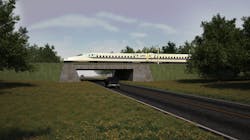Project Update: Bullet Train Brings Texas Into the High-Speed Era
The high-speed rail corridor that is underway in Texas, would connect riders from Houston and Dallas/Fort Worth. The high speed rail line is headed by the privately owned company, Texas Central, which is behind the proposed line. When the project was first being developed there were ninety-six different city pairings that were examined. Developers found that the cities that would benefit most from the line would be the pairings from North Texas to Houston.
“The high-speed train is a first-of-a-kind high-speed rail project in Texas and the nation. The 240-mile high-speed train project connects North Texas and Houston — two of the nation’s largest and fastest-growing economies — at 200 mph, with one stop in the Brazos Valley,” explained Holly Reed, managing director of external affairs for Texas Central. “This 90-minute train experience gives Texans the freedom of choice, providing an alternative to today’s 4.5-hour drive or unpredictable air travel.”
In a dedication to safety and minimal impact, the bullet train is set to be built on its own dedicated corridor. That means that there are no areas where the train would come into contact with cars or pedestrians. Areas where the bullet train would cross roadways, it will be built either above or beneath the road, there will be no need for rail crossings.
“The Texas high-speed train will use the safest and most reliable technology in the world. The Texas Bullet Train puts safety at the heart of every decision and upholds the strictest safety mindset that will provide Texans with the safest high-speed train experience in the world,” said Reed.
Benefiting the community
One of the reasons behind the decision to build the HSR line between North Texas and Houston was that around 50,000 Texans — who have been dubbed as “super-commuters” — that make the trip either weekly or regularly. Commuters would see their time drastically reduced, the train would depart around every 30 minutes during peak commuting times and during off-peak times the train would operate hourly.
“The train provides a vital service to Texans that will cut congestion and alleviate stress on infrastructure, as the Texas population and demands on our interstates surge,” said Reed.
BY THE NUMBERS
- 10,000 direct jobs during each year of construction
- 1,000 direct jobs in a new high-tech industry in the US
- >$10 billion direct investment from the project’s infrastructure, design and construction
- $36 billion direct impact from the economic benefits the project will generate over the next 25 years
- $2.5 billion tax revenue estimated to be paid by the company to the state, counties, local municipalities and school districts
- $0 in federal or state grants for construction or operation
The Texas Bullet Train is projected to generate billions of dollars of investment into the Texas economy. The benefits would be reflected in both the economic impact as well as the creation of over a thousand jobs.
“The project is expected to generate $36 billion in direct economic activity over 25 years, create 10,000 per year during construction and up to 1,000 jobs permanently when operational,” said Reed. “Many of these jobs will involve construction within the city, including building the rail line along the Hempstead Highway and the Houston terminal. “
Building partnerships
Texas Central has been streamlining partnerships in the development of the bullet train. The company recently partnered with two engineering firms to progress the construction.
“Texas Central announced an agreement with Fluor and Lane to help with engineering and design work, two firms that have deep Texas roots,” said Reed. “This is just the latest in a long list of Texas-focused companies helping build the Texas Bullet train, including Freese & Nichols, Contract Land Staff and Survey and Mapping.”
The agreement between Texas Central, Fluor and the Lane Construction Corporation was announced on August 14. Both companies were brought on to work together in the continued development of the project’s construction planning, sequencing, scheduling, cost estimates, procurement and any other design related aspects related to the HSR’s infrastructure.
Texas Central announced that under the agreement, after the development phase and financial close, Fluor and Lane would be the preferred design-builder of the project.
Developing for the future
The project design and construction is still currently underway, as Texas Central moves forward the company is working to align all the essential details.
“Teams continue working on the project every day, doing the environmental assessments, engineering and other areas. The Federal Railroad Administration continues to work on the preparation of the Draft Environmental Impact Statement. This environmental review will help determine the project timeline and final route,” said Reed.
Projections for ridership is positive, with Texas’s “super-commuters” anticipated to save at least an hour by utilizing the HSR line.
“According to a recent ridership study by L.E.K. Consulting, more than 90 percent of those in North Texas or Houston would save about an hour or more by taking the train,” said Reed. “The study demonstrated a massive and growing market for the 90-minute, 240-mile trip between North Texas and Houston, with one stop in the Brazos Valley. More than 80 percent of 2,000 residents surveyed say they would consider using the bullet train.”
Aside from the cut in commute times, future riders are expressing excitement about the rail line.
“People are excited to ride the Texas Bullet Train. The rider experience will be unique and different than anything you can experience in our state or nation today. The Texas Bullet Train will provide the most reliable, technology-enabled and comfortable transportation option in the state,” Reed explained.
Thus far Texas Central has received statements of support from over 50 community groups and organizations, highlighting the fact that the bullet train is a welcome addition to the infrastructure of Texas.
